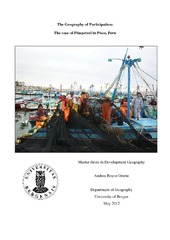| dc.contributor.author | Boyco Orams, Andrea | eng |
| dc.date.accessioned | 2012-11-08T09:16:16Z | |
| dc.date.available | 2012-11-08T09:16:16Z | |
| dc.date.issued | 2012-05-08 | eng |
| dc.identifier.uri | https://hdl.handle.net/1956/6167 | |
| dc.description.abstract | This study analyses how public participation is shaped geographically in the extractive industry in Peru. Focusing on a special sector of the Camisea Gas Project, I take into analysis the different formal and informal institutions that take part in shaping the process. Participatory development theory aims towards a transformative process, towards empowering the marginalized. This stage is very difficult to achieve because it implies changes in the power structures, so at the moment it can be found being applied mostly as an informative process. The instrumental use being given to participatory techniques has brought critiques towards the process because it has not managed to confront top-down approaches. I am structuring the paper around the concept of the geography of participation' meaning the inclusion and exclusion of stakeholders together with the creation and delimitation of spaces for developing a participatory process. The case study reinforces some of the critiques brought up against the theory of participatory development but provides some examples of alternatives ways of empowerment which, although differ from the theory, if applied correctly, could get the local participatory process closer to what was aimed when the theory was conceived. Participation takes place in socially constructed spaces. I analyse how the merging of the processes and negotiations associated with the formal institutions (the legislation), and the processes and outcomes of the informal institutions, or unregulated patterns of behaviour, frame each participatory process creating unique spaces of interaction. I argue that the participation process is being shaped by the combination of both sets of institutions, they condition each others existence and the success of their outcomes, creating a situation which is very difficult to replicate. This case study represents how even though there are existing intentions to include the concept of participation into the legislation and apply it correctly, there is still a lot of work to be done. Transformation therefore, is a long way ahead. | en_US |
| dc.description.abstract | Este estudio analiza como la participación ciudadana está enmarcada geográficamente en el sector de industrias extractivas en Perú. Al enfocarme en un sector especial del Proyecto del Gas de Camisea, analizo como las distintas instituciones formales e informales le dan forma al proceso. La teoría de desarrollo participativo tiene como objetivo un proceso de transformación que busca empoderar a los marginados. Este nivel es difícil de conseguir ya que implica cambios en las estructuras de poder, por lo que por ahora se puede encontrar principalmente como mecanismos informativos. El uso instrumental que se le está dando a las técnicas de participación ha levantado críticas hacia el proceso ya que no ha logrado desafiar enfoques impuestos desde arriba. Estoy estructurando este documento alrededor del concepto de la geografía de la participación' entendiéndolo como la inclusión y exclusión de las partes interesadas, junto con la creación y delimitación de espacios para desarrollar un proceso participativo. El estudio de caso refuerza algunas de las críticas que existen hacia la teoría de desarrollo participativo pero brinda algunos ejemplos de modos alternativos de empoderamiento, que aunque difieren de la teoría, si son aplicados correctamente podría llevar el proceso de participación local a lo que la teoría considera como correcto. La participación se lleva a cabo en espacios que son socialmente construidos. Estoy analizando como la fusión de los procesos y negociaciones asociados con las instituciones formales (la legislación), y los procesos y resultados de las instituciones informales, o los patrones de comportamiento que no son regulados, enmarcan cada proceso participativo creando espacios únicos de interacción. Sostengo que el proceso de participación está formado por la combinación de ambos grupos de instituciones, los cuales condicionan la existencia de ellos mismos y el éxito de sus productos, creando una situación que es complicada de replicar. Este estudio de caso representa como, aunque existe la intención de incluir el concepto de participación en la legislación y aplicarlo correctamente, todavía hay un camino largo por recorrer. La transformación, por lo tanto, todavía es una idea lejana. | en_US |
| dc.language.iso | eng | eng |
| dc.publisher | The University of Bergen | eng |
| dc.subject | Public participation | eng |
| dc.subject | Extractive industry | eng |
| dc.subject | Fishermen | eng |
| dc.subject | Peru | eng |
| dc.title | The Geography of Participation: The case of Pluspetrol in Pisco, Peru | eng |
| dc.type | Master thesis | en_US |
| dc.rights.holder | Copyright the author. All rights reserved | en_US |
| dc.description.degree | Master in Development Geography | |
| dc.description.localcode | GEO350 | |
| dc.description.localcode | MASV-GEOG | |
| dc.subject.nus | 733111 | eng |
| fs.subjectcode | GEO350 | |
